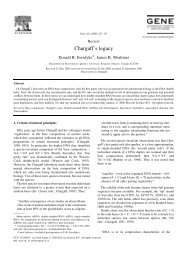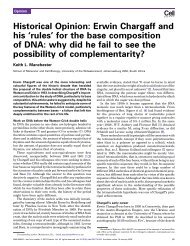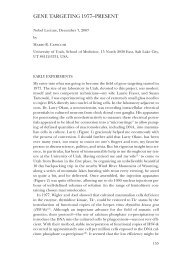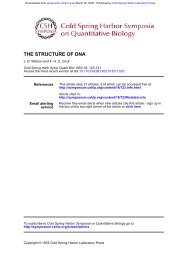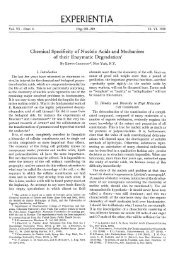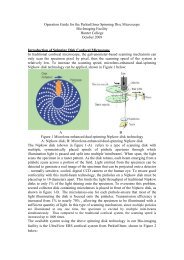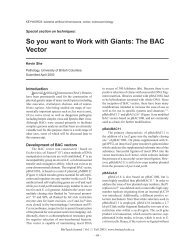Downloaded from genome.cshlp.org on January 29, 2011 - Published by Cold Spring Harbor Laboratory PressWhat is a <strong>gene</strong>?changed dramatically over the past century. For Morgan, <strong>gene</strong>son chromosomes were like beads on a string. The molecular biologyrevolution changed this idea considerably. To quote Falk(1986), ‘‘. . . the <strong>gene</strong> is [. . .]neither discrete [. . .] nor continuous[. . .], nor does it have a constant location [. . .], nor a clearcutfunction [. . .], not even constant sequences [. . .] nor definiteborderlines.’’ And now the ENCODE project has increased thecomplexity still further.What has not changed is that genotype determines phenotype,and at the molecular level, this means that DNA sequencesdetermine the sequences <strong>of</strong> functional molecules. In the simplestcase, one DNA sequence still codes for one protein or RNA. But inthe most <strong>gene</strong>ral case, we can have <strong>gene</strong>s consisting <strong>of</strong> sequencemodules that combine in multiple ways to <strong>gene</strong>rate products. Byfocusing on the functional products <strong>of</strong> the genome, this definitionsets a concrete standard in enumerating unambiguously thenumber <strong>of</strong> <strong>gene</strong>s it contains.An important aspect <strong>of</strong> our proposed definition is the requirementthat the protein or RNA products must be functionalfor the purpose <strong>of</strong> assigning them to a particular <strong>gene</strong>. We believethis connects to the basic principle <strong>of</strong> <strong>gene</strong>tics, that genotypedetermines phenotype. At the molecular level, we assume thatphenotype relates to biochemical function. Our intention is tomake our definition backwardly compatible with earlier concepts<strong>of</strong> the <strong>gene</strong>.This emphasis on functional products, <strong>of</strong> course, highlightsthe issue <strong>of</strong> what biological function actually is. With this, wemove the hard question from “what is a <strong>gene</strong>?” to “what is afunction?”High-throughput biochemical and mutational assays will beneeded to define function on a large scale (Lan et al. 2002, 2003).Hopefully, in most cases it will just be a matter <strong>of</strong> time until weacquire the experimental evidence that will establish what mostRNAs or proteins do. Until then we will have to use “placeholder”terms like TAR, or indicate our degree <strong>of</strong> confidence inassuming function for a genomic product. We may also be able toinfer functionality from the statistical properties <strong>of</strong> the sequence(e.g., Ponjavic et al. 2007).However, we probably will not be able to ever know thefunction <strong>of</strong> all molecules in the genome. It is conceivable thatsome genomic products are just “noise,” i.e., results <strong>of</strong> evolutionarilyneutral events that are tolerated by the organism (e.g., Tresset al. 2007). Or, there may be a function that is shared by so manyother genomic products that identifying function by mutationalapproaches may be very difficult. While determining biologicalfunction may be difficult, proving lack <strong>of</strong> function is even harder(almost impossible). Some sequence blocks in the genome arelikely to keep their labels <strong>of</strong> “TAR <strong>of</strong> unknown function” indefinitely.If such regions happen to share sequences with functional<strong>gene</strong>s, their boundaries (or rather, the membership <strong>of</strong> their sequenceset) will remain uncertain. Given that our definition <strong>of</strong> a<strong>gene</strong> relies so heavily on functional products, finalizing the number<strong>of</strong> <strong>gene</strong>s in our genome may take a long time.AcknowledgmentsWe thank the ENCODE consortium, and acknowledge the followingfunding sources: ENCODE grant #U01HG03156 from theNational Human Genome Research Institute (NHGRI)/NationalInstitutes <strong>of</strong> Health (NIH); NIH Grant T15 LM07056 from theNational Library <strong>of</strong> Medicine (C.B., Z.D.Z.); and a Marie CurieOutgoing International Fellowship (J.O.K).ReferencesAkiva, P., Toporik, A., Edelheit, S., Peretz, Y., Diber, A., Shemesh, R.,Novik, A., and Sorek, R. 2006. Transcription-mediated <strong>gene</strong> fusion inthe human genome. Genome Res. 16: 30–36.Avery, O.T., MacLeod, C.M., and McCarty, M. 1944. Studies on thechemical nature <strong>of</strong> the substance inducing transformation <strong>of</strong>pneumococcal types. J. Exp. Med. 79: 137–158.Balakirev, E.S. and Ayala, F.J. 2003. Pseudo<strong>gene</strong>s: Are they “junk” orfunctional DNA? Annu. Rev. Genet. 37: 123–151.Beadle, G.W. and Tatum, E.L. 1941. Genetic control <strong>of</strong> biochemicalreactions in Neurospora. Proc. Natl. Acad. Sci. 27: 499–506.Benzer, S. 1955. Fine structure <strong>of</strong> a <strong>gene</strong>tic region in bacteriophage. Proc.Natl. Acad. Sci. 41: 344–354.Berget, S.M., Moore, C., and Sharp, P.A. 1977. Spliced segments at the 5terminus <strong>of</strong> adenovirus 2 late mRNA. Proc. Natl. Acad. Sci.74: 3171–3175.Bertone, P., Stolc, V., Royce, T.E., Rozowsky, J.S., Urban, A.E., Zhu, X.,Rinn, J.L., Tongprasit, W., Samanta, M., Weissman, S., et al. 2004.Global identification <strong>of</strong> human transcribed sequences with genometiling arrays. Science 306: 2242–2246.Blumenthal, T. 2005. Trans-splicing and operons. WormBook (ed. TheC. elegans Research Community). WormBook, doi/10.1895/wormbook.1.5.1, http://www.wormbook.org.Borst, P. 1986. Discontinuous transcription and antigenic variation intrypanosomes. Annu. Rev. Biochem. 55: 701–732.Cawley, S., Bekiranov, S., Ng, H.H., Kapranov, P., Sekinger, E.A., Kampa,D., Piccolboni, A., Sementchenko, V., Cheng, J., Williams, A.J., et al.2004. Unbiased mapping <strong>of</strong> transcription factor binding sites alonghuman chromosomes 21 and 22 points to widespread regulation <strong>of</strong>noncoding RNAs. Cell 116: 499–509.Cheng, J., Kapranov, P., Drenkow, J., Dike, S., Brubaker, S., Patel, S.,Long, J., Stern, D., Tammana, H., Helt, G., et al. 2005.Transcriptional maps <strong>of</strong> 10 human chromosomes at 5-nucleotideresolution. Science 308: 1149–1154.Chow, L.T., Gelinas, R.E., Broker, T.R., and Roberts, R.J. 1977. Anamazing sequence arrangement at the 5 ends <strong>of</strong> adenovirus 2messenger RNA. Cell 12: 1–8.Chureau, C., Prissette, M., Bourdet, A., Barbe, V., Cattolico, L., Jones, L.,Eggen, A., Avner, P., and Duret, L. 2002. Comparative sequenceanalysis <strong>of</strong> the X-inactivation center region in mouse, human, andbovine. Genome Res. 12: 894–908.Contreras, R., Rogiers, R., Van de, V.A., and Fiers, W. 1977. Overlapping<strong>of</strong> the VP2-VP3 <strong>gene</strong> and the VP1 <strong>gene</strong> in the SV40 genome. Cell12: 529–538.Crick, F.H.C. 1958. On protein synthesis. Symp. Soc. Exp. Biol.X<strong>II</strong>: 138–163.Dawkins, R. 1976. The selfish <strong>gene</strong>. Oxford University Press, Oxford, UK.Denoeud, F., Kapranov, P., Ucla, C., Frankish, A., Castelo, R., Drenkow,J., Lagarde, J., Alioto, T., Manzano, C., Chrast, J., et al. 2007.Prominent use <strong>of</strong> distal 5 transcription start sites and discovery <strong>of</strong> alarge number <strong>of</strong> additional exons in ENCODE regions. Genome Res.(this issue) doi: 10.1101/gr5660607.Dobrovic, A., Gareau, J.L., Ouellette, G., and Bradley, W.E. 1988. DNAmethylation and <strong>gene</strong>tic inactivation at thymidine kinase locus:Two different mechanisms for silencing autosomal <strong>gene</strong>s. Somat. CellMol. Genet. 14: 55–68.Doolittle, R. 1986. Of URFs and ORFs: A primer on how to analyze derivedamino acid sequences. University Science Books, Mill Valley, CA.Du, J., Rozowsky, J.S., Korbel, J., Zhang, Z.D., Royce, T.E., Schultz, M.H.,Snyder, M., and Gerstein, M. 2006. A supervised hidden Markovmodel framework for efficiently segmenting tiling array data intranscriptional and ChIP–chip experiments: Systematicallyincorporating validated biological knowledge. Bioinformatics22: 3016–3024.Duret, L., Chureau, C., Samain, S., Weissenbach, J., and Avner, P. 2006.The Xist RNA <strong>gene</strong> evolved in eutherians by pseudogenization <strong>of</strong> aprotein-coding <strong>gene</strong>. Science 312: 1653–1655.Early, P., Huang, H., Davis, M., Calame, K., and Hood, L. 1980. Animmunoglobulin heavy chain variable region <strong>gene</strong> is <strong>gene</strong>rated fromthree segments <strong>of</strong> DNA: VH, D and JH. Cell 19: 981–992.Eddy, S.R. 2001. Non-coding RNA <strong>gene</strong>s and the modern RNA world.Nat. Rev. Genet. 2: 919–929.Eisen, H. 1988. RNA editing: Who’s on first? Cell 53: 331–332.Emanuelsson, O., Nagalakshmi, U., Zheng, D., Rozowsky, J.S., Urban,A.E., Du, J., Lian, Z., Stolc, V., Weissman, S., Snyder, M., et al. 2007.Assessing the performance <strong>of</strong> different high-density tiling microarraystrategies for mapping transcribed regions <strong>of</strong> the human genome.Genome Res. (this issue) doi: 10.1101/gr.5014606.The ENCODE Project Consortium. 2007. Identification and analysis <strong>of</strong>functional elements in 1% <strong>of</strong> the human genome by the ENCODEGenome Research 679www.genome.org
Downloaded from genome.cshlp.org on January 29, 2011 - Published by Cold Spring Harbor Laboratory PressGerstein et al.pilot project. Nature (in press).Euskirchen, G., Royce, T.E., Bertone, P., Martone, R., Rinn, J.L., Nelson,F.K., Sayward, F., Luscombe, N.M., Miller, P., Gerstein, M., et al.2004. CREB binds to multiple loci on human chromosome 22. Mol.Cell. Biol. 24: 3804–3814.Falk, R. 1986. What is a <strong>gene</strong>? Stud. Hist. Philos. Sci. 17: 133–173.Fiers, W., Contreras, R., De Wachter, R., Haegeman, G., Merregaert, J.,Jou, W.M., and Vandenberghe, A. 1971. Recent progress in thesequence determination <strong>of</strong> bacteriophage MS2 RNA. Biochimie53: 495–506.Fiers, W., Contreras, R., Duerinck, F., Haegeman, G., Iserentant, D.,Merregaert, J., MinJou, W., Molemans, F., Raeymakers, A., Van denBerghe, A., et al. 1976. Complete nucleotide sequence <strong>of</strong>bacteriophage MS2 RNA: Primary and secondary structure <strong>of</strong> thereplicase <strong>gene</strong>. Nature 260: 500–507.Fleischmann, R.D., Adams, M.D., White, O., Clayton, R.A., Kirkness,E.F., Kerlavage, A.R., Bult, C.J., Tomb, J.F., Dougherty, B.A., Merrick,J.M., et al. 1995. Whole-genome random sequencing and assembly<strong>of</strong> Haemophilus influenzae Rd. Science 269: 496–512.Frith, M.C., Wilming, L.G., Forrest, A., Kawaji, H., Tan, S.L., Wahlestedt,C., Bajic, V.B., Kai, C., Kawai, J., Carninci, P., et al. 2006.Pseudo-messenger RNA: Phantoms <strong>of</strong> the transcriptome. PLoS Genet.2: e23.Gelinas, R.E. and Roberts, R.J. 1977. One predominant5-undecanucleotide in adenovirus 2 late messenger RNAs. Cell11: 533–544.Gibbons, F.D., Pr<strong>of</strong>t, M., Struhl, K., and Roth, F.P. 2005. Chipper:Discovering transcription-factor targets from chromatinimmunoprecipitation microarrays using variance stabilization.Genome Biol. 6: R96.Gingeras, T. 2007. Origin <strong>of</strong> phenotypes: Genes and transcripts. GenomeRes. (this issue) doi: 10.1101/gr.625007.Griffith, F. 1928. The significance <strong>of</strong> pneumococcal types. J. Hyg. (Lond.)27: 113–159.Griffiths, P.E. and Stotz, K. 2006. Genes in the postgenomic era. Theor.Med. Bioeth. 27: 499–521.Handa, H., Bonnard, G., and Grienenberger, J.M. 1996. The rapeseedmitochondrial <strong>gene</strong> encoding a homologue <strong>of</strong> the bacterial proteinCcl1 is divided into two independently transcribed reading frames.Mol. Gen. Genet. 252: 293–302.Harrison, P.M., Zheng, D., Zhang, Z., Carriero, N., and Gerstein, M.2005. Transcribed processed pseudo<strong>gene</strong>s in the human genome: Anintermediate form <strong>of</strong> expressed retrosequence lacking protein-codingability. Nucleic Acids Res. 33: 2374–2383.Harrow, J., Denoeud, F., Frankish, A., Reymond, A., Chen, C.K., Chrast,J., Lagarde, J., Gilbert, J.G., Storey, R., Swarbreck, D., et al. 2006.GENCODE: Producing a reference annotation for ENCODE. GenomeBiol. 7 Suppl. 1: S4.1–S9.Heber, S., Alekseyev, M., Sze, S., Tang, H., and Pevzner, P.A. 2002.Splicing graphs and EST assembly problem. Bioinformatics18: S181–S188.Heimans, J. 1962. Hugo de Vries and the <strong>gene</strong> concept. Am. Nat.96: 93–104.Henik<strong>of</strong>f, S., Keene, M.A., Fechtel, K., and Fristrom, J.W. 1986. Genewithin a <strong>gene</strong>: Nested Drosophila <strong>gene</strong>s encode unrelated proteins onopposite DNA strands. Cell 44: 33–42.Hershey, A.D. and Chase, M. 1955. An upper limit to the proteincontent <strong>of</strong> the germinal substance <strong>of</strong> bacteriophage T2. Virology1: 108–127.Iafrate, A.J., Feuk, L., Rivera, M.N., Listewnik, M.L., Donahoe, P.K., Qi,Y., Scherer, S.W., and Lee, C. 2004. Detection <strong>of</strong> large-scale variationin the human genome. Nat. Genet. 36: 949–951.Jacob, F. and Monod, J. 1961. Genetic regulatory mechanisms in thesynthesis <strong>of</strong> proteins. J. Mol. Biol. 3: 318–356.Ji, H. and Wong, W.H. 2005. TileMap: Create chromosomal map <strong>of</strong>tiling array hybridizations. Bioinformatics 21: 3629–3636.Johannsen, W. 1909. Elemente der exakten Erblichkeitslehre, Jena.Quoted by Nils Roll-Hansen (1989). The crucial experiment <strong>of</strong>Wilhelm Johannsen. Biol. Philos. 4: 303–329.Kapranov, P., Cawley, S.E., Drenkow, J., Bekiranov, S., Strausber, R.L.,Fodor, S.P., and Gingeras, T.R. 2002. Large-scale transcriptionalactivity in chromosomes 21 and 22. Science 296: 916–919.Karplus, K., Barrett, C., Cline, M., Diekhans, M., Grate, L., and Hughey,R. 1999. Predicting protein structure using only sequenceinformation. Proteins 37 (Suppl 3): 121–125.Kim, T.H., Barrera, L.O., Zheng, M., Qu, C., Singer, M.A., Richmond,T.A., Wu, Y., Green, R.D., and Ren, B. 2005. A high-resolution map<strong>of</strong> active promoters in the human genome. Nature 436: 876–880.Korneev, S.A., Park, J.H., and O’Shea, M. 1999. Neuronal expression <strong>of</strong>neural nitric oxide synthase (nNOS) protein is suppressed by anantisense RNA transcribed from an NOS pseudo<strong>gene</strong>. J. Neurosci.19: 7711–7720.Lan, N., Jansen, R., and Gerstein, M. 2002. Towards a systematicdefinition <strong>of</strong> protein function that scales to the genome level:Defining function in terms <strong>of</strong> interactions. Proc. IEEE 90: 1848–1858.Lan, N., Montelione, G.T., and Gerstein, M. 2003. Ontologies forproteomics: Towards a systematic definition <strong>of</strong> structure andfunction that scales to the genome level. Curr. Opin. Chem. Biol.7: 44–54.Lander, E.S., Linton, L.M., Birren, B., Nusbaum, C., Zody, M.C.,Baldwin, J., Devon, K., Dewar, K., Doyle, M., FitzHugh, W., et al.2001. Initial sequencing and analysis <strong>of</strong> the human genome. Nature409: 860–921.Li, W., Meyer, C.A., and Liu, X.S. 2005. A hidden Markov model foranalyzing ChIP–chip experiments on genome tiling arrays and itsapplication to p53 binding sequences. Bioinformatics 21: i274–i282.Lindblad-Toh, K.C.M., Wade, T.S., Mikkelsen, E.K., Karlsson, D.B., Jaffe,M., Kamal, M., Clamp, J.L., Chang, E.J., Kulbokas 3rd, M.C., Zody,E., et al. 2005. Genome sequence, comparative analysis andhaplotype structure <strong>of</strong> the domestic dog. Nature 438: 803–819.Lodish, H., Scott, M.P., Matsudaira, P., Darnell, J., Zipursky, L., Kaiser,C.A., Berk, A., and Krieger, M. 2000. Molecular cell biology, 5th ed.Freeman and Co., New York.Marioni, J.C., Thorne, N.P., and Tavare, S. 2006. BioHMM: Ahetero<strong>gene</strong>ous hidden Markov model for segmenting array CGHdata. Bioinformatics 22: 1144–1146.Mattick, J.S. and Makunin, I.V. 2006. Non-coding RNA. Hum. Mol.Genet. 15 Spec. No. 1: R17–R29.McClintock, B. 1929. A cytological and <strong>gene</strong>tical study <strong>of</strong> triploid maize.Genetics 14: 180–222.McClintock, B. 1948. Mutable loci in maize. Carnegie Inst. Wash. YearBook 47: 155–169.Mendel, J.G. 1866. Versuche über Pflanzenhybriden. Verhandlungen desnaturforschenden Vereines in Brünn 4 Abhandlungen, 3–47. Citedby Robert C. Olby (1997) onhttp://www.mendelweb.org/MWolby.html, accessed 2007-03-16.Morgan, T.H., Sturtevant, A.H., Muller, H.J., and Bridges, C.B. 1915. Themechanism <strong>of</strong> Mendelian heredity. Holt Rinehart & Winston, NewYork.Muller, H.J. 1927. Artificial transmutation <strong>of</strong> the <strong>gene</strong>. Science 46: 84–87.Nirenberg, M., Leder, P., Bernfield, M., Brimacombe, R., Trupin, J.,Rottman, F., and O’Neal, C. 1965. RNA codewords and proteinsynthesis, V<strong>II</strong>. On the <strong>gene</strong>ral nature <strong>of</strong> the RNA code. Proc. Natl.Acad. Sci. 53: 1161–1168.Ohno, S. 1972. So much “junk” DNA in the genome. In Evolution <strong>of</strong><strong>gene</strong>tic systems, vol. 23 (ed. H.H. Smith), pp. 366–370. BrookhavenSymposia in <strong>Biology</strong>. Gordon & Breach, New York.Parra, G., Reymond, A., Dabbouseh, N., Dermitzakis, E.T., Castelo, R.,Thomson, T.M., Antonarakis, S.E., and Guigó, R. 2006. Tandemchimerism as a means to increase protein complexity in the humangenome. Genome Res. 16: 37–44.Paul, J. 1972. General theory <strong>of</strong> chromosome structure and <strong>gene</strong>activation in eukaryotes. Nature 238: 444–446.Pearson, H. 2006. Genetics: What is a <strong>gene</strong>? Nature 441: 398–401.Pedersen, J.S., Bejerano, G., Siepel, A., Rosenbloom, K., Lindblad-Toh,K., Lander, E.S., Kent, J., Miller, W., and Haussler, D. 2006.Identification and classification <strong>of</strong> conserved RNA secondarystructures in the human genome. PLoS Comput. Biol. doi:10.1371/journal.pcbi.0020033.Ponjavic, J., Ponting, C.P., and Lunter, G. 2007. Functionality ortranscriptional noise? Evidence for selection within long noncodingRNAs. Genome Res. 17: 556–565.Quelle, D.E., Zindy, F., Ashmun, R.A., and Sherr, C.J. 1995. Alternativereading frames <strong>of</strong> the INK4a tumor suppressor <strong>gene</strong> encode twounrelated proteins capable <strong>of</strong> inducing cell cycle arrest. Cell83: 993–1000.Rheinberger, H.G. 1995. When did Darl Correns read Gregor Mendel’spaper? Isis 86: 612–616.Rinn, J.L., Euskirchen, G., Bertone, P., Martone, R., Luscombe, N.M.,Hartman, S., Harrison, P.M., Nelson, F.K., Mille, P., Gerstein, M., etal. 2003. The transcriptional activity <strong>of</strong> human chromosome 22.Genes & Dev. 17: 529–540.Rogic, S., Mackworth, A.K., and Ouellette, F.B. 2001. Evaluation <strong>of</strong><strong>gene</strong>-finding programs on mammalian sequences. Genome Res.11: 817–832.Rozowsky, J., Newburger, D., Sayward, F., Wu, J., Jordan, G., Korbel,J.O., Nagalakshmi, U., Yang, J., Zheng, D., Guigo, R., et al. 2007. TheDART classification <strong>of</strong> unannotated transcription within theENCODE regions: Associating transcription with known and novelloci. Genome Res. (this issue) doi: 10.1101/gr.5696007.Sager, R. and Kitchin, R. 1975. Selective silencing <strong>of</strong> eukaryotic DNA.Science 189: 426–433.680 Genome Researchwww.genome.org



